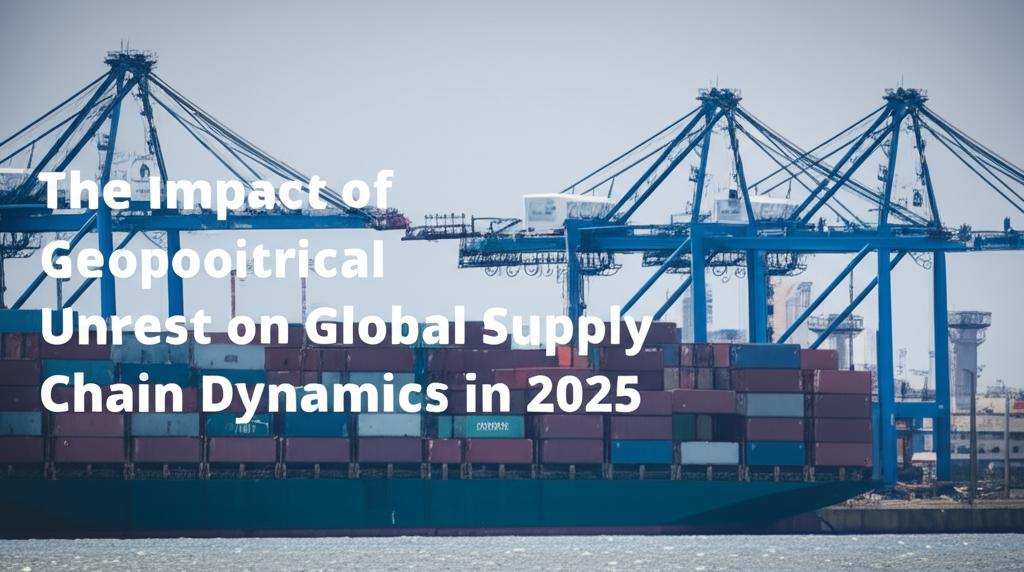The year 2025 presents a demanding and unpredictable environment for global supply chains, largely shaped by ongoing and emerging geopolitical unrest. This turbulence stems from a variety of interconnected factors, creating a complex web of challenges that businesses must navigate with agility and foresight.
Key Geopolitical Stressors and Their Supply Chain Repercussions:- Armed Conflicts and Regional Instability: Persistent conflicts, such as the war in Ukraine, and tensions in regions like the Middle East (including the Red Sea crisis) and the South China Sea, continue to be primary disruptors. These events directly impact trade routes, leading to delays, increased shipping costs, and the need to find alternative pathways. The security of maritime chokepoints remains a significant concern, forcing companies to reroute shipments, often at considerable expense and time. Proxy wars, civil unrest, and coups in various parts of the world further destabilize regional supply networks and the availability of critical materials.
- Trade Tensions and Protectionism: Rising nationalism and protectionist policies, including new tariffs and trade barriers, are reshaping global trade flows. For instance, continued trade friction between major economies like the U.S. and China, and the potential for new tariffs (such as proposed U.S. tariffs on goods from China, Mexico, and Canada), compel businesses to reassess sourcing strategies. This can lead to shifts like nearshoring or onshoring, which, while potentially reducing geopolitical risk exposure, may increase short-term costs and necessitate new infrastructure development. "Connector countries" – those used to bypass trade controls – may themselves become targets of trade barriers, adding another layer of volatility.
- Economic Instability: Geopolitical instability frequently fuels economic uncertainty. Persistent inflation, fluctuating currency exchange rates, and the potential for weaker global economic conditions in 2025 create a difficult operating environment. This economic strain can lead to social unrest and calls for political change, further exacerbating supply chain risks.
- Cyber Warfare and Technological Threats: Cyberattacks are increasingly used as a tool in international conflicts, posing a significant threat to the digitized and interconnected nature of modern supply chains. Disruptions can target critical infrastructure, logistics platforms, and supplier systems, leading to data breaches, operational shutdowns, and financial losses. The security of AI integrated into supply chain operations also presents new challenges, including risks of data poisoning and model corruption.
- Resource Scarcity and Competition: Geopolitical rivalries intensify competition for critical resources, including energy, food, and vital minerals. Export controls and national stockpiling efforts can restrict access to these materials, impacting production continuity and costs, particularly for industries reliant on specific commodities like semiconductors or rare earth metals.
- Regulatory Fragmentation and Compliance: Shifting geopolitical alliances and national priorities are leading to a more complex and fragmented global regulatory landscape. Businesses must navigate evolving trade policies, sanctions, and environmental, social, and governance (ESG) compliance requirements across different jurisdictions, which can increase operational costs and complexity.
- Climate Change as a Geopolitical Stressor: While an environmental issue, climate change is increasingly intertwined with geopolitics. Extreme weather events (floods, droughts, wildfires) disrupt logistics, damage infrastructure, and affect agricultural production. Differing national commitments and approaches to climate change mitigation can also create trade tensions and impact global efforts to build resilient infrastructure.
In this era of "unprecedented supply chain risk," pure risk avoidance is no longer feasible. Instead, organizations are focusing on building resilience and anti-fragility through proactive, agile, and adaptive risk management. Key strategies include:
- Enhanced Visibility and Risk Assessment: A deep understanding of multi-tier supplier networks is crucial to identify vulnerabilities and potential chokepoints. Real-time monitoring of geopolitical developments, trade policy shifts, and emerging threats is essential.
- Supplier Diversification: Reducing reliance on single-source suppliers or geographically concentrated regions is a primary strategy. Building a diverse portfolio of suppliers across different territories can help mitigate the impact of localized disruptions.
- Regionalization and Nearshoring: Shifting some production or sourcing closer to home or to "safer" territories can reduce exposure to distant geopolitical flare-ups, though it may involve higher initial costs.
- Building Robustness: Implementing strategies like index-linked contracts can help manage cost volatility. Maintaining stricter compliance levels, even beyond minimum government requirements, can safeguard against sudden regulatory changes.
- Investing in Technology: Leveraging AI and machine learning for predictive analytics, demand forecasting, and route optimization can help businesses anticipate and respond to disruptions more effectively. Robust cybersecurity measures are also paramount.
- Strategic Partnerships and Collaboration: Strengthening relationships with suppliers, logistics providers, and even governments can foster greater collaboration in navigating complex geopolitical challenges.
- Contingency Planning and Agility: Developing comprehensive contingency plans for various disruption scenarios and fostering an organizational culture that can adapt quickly to changing circumstances are vital.
The overarching message for 2025 is that geopolitical instability is not a transient issue but a defining feature of the global landscape. Supply chain leaders must treat geopolitical risk as a fundamental aspect of their strategic and operational decision-making, moving from reactive responses to proactive and holistic risk management to ensure continuity, compliance, and competitiveness.

